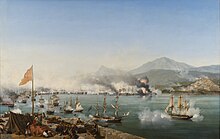Tunisian navy (1705–1881)
Until 1815 the Beylik of Tunis maintained a corsair navy to attack European shipping, raid coastal towns on the northern shores of the Mediterranean and defend against incursions from Algiers or Tripoli.
Corsairing was less important to the economy of Tunis than to the other Barbary States, but under Yusuf Dey in the early seventeenth century it grew in scale, and the capture of foreign ships became a key source of income for the ruler.
The selling of European captives back to their countries of origin and the purchase of ship hulls from foreign ports went on continuously, but at times when the profitability of agriculture or trade rose, corsair activity tended to decline, as, for example, during the periods 1660–1705 and 1760–1792.
[2] Like Algiers and Tripoli, Tunis needed to import most of the materials necessary to build and maintain a fleet, including rope, tar, sails and anchors and the wood necessary to convert captured merchantmen into warships.
The Ben Ayyed family chartered 36 percent of the Tunisian corsair fleet between 1764 and 1815 (making them the second largest), paying a tithe (uchur) for the privilege, but the profits they yielded were not significant.
[7][8] It thus became increasingly difficult for Tunis to build, equip, man or maintain a naval force that could remain effective in the face of other modern navies in the Mediterranean.
[13] The harbour at La Goulette was exposed to enemy attack, so in 1818, fearing that Lord Exmouth would destroy his entire navy as he had the Algerian fleet, Mahmud Bey had the entrance to Porto Farina dredged clear do that he could move his ships back there, where they could shelter in the lagoon.
[14]: 121 Over time, various maritime countries signed treaties with Tunis, agreeing to make gifts and payments in return for security against attack and enslavement.
[18]: 52 [14]: 236 An offer from Sweden in 1814 worth 75,000 piastres to the Bey, with regular payments every three years to secure the safety of its shipping was considered inadequate and not accepted.
[14]: 303 Having secured these subsidies with the threat of piracy, Tunis and the other Barbary states did not always adhere to their obligations, and at times they still seized shipping from countries with which they had treaties.
On 19 July 1728 a naval force under Etienne Nicolas de Grandpré [fr] consisting of two ships of the line, three frigates, a flute, three bomb galiots and two galleys left Toulon.
[21] When a dispute over Corsican shipping and the rights to coral fishing in Tabarka led to the outbreak of war with France in June 1770, the Tunisian fleet did not attempt to engage the French navy, which was able to bombard Porto Farina, Bizerte and Sousse with impunity.
[14]: 170–185 In 1784 a dispute with the Republic of Venice led to war; on 1 September a Venetian fleet of three ships of the line, a frigate, two xebecs and a galiot appeared off Tunis.
Thus in 1799 a fleet of twelve corsairs under the command of Mohammed Rais Roumali raided San Pietro Island off Sardinia, carrying its entire population away into slavery.
[18]: 52 Hostilities were threatened during the First Barbary War when the USS Constitution seized a Tunisian corsair and its prizes that were attempting to run the US blockade of Tripoli.
Mahmud Bey dispatched eight Corsair ships under Moustafa Reis to pillage the coasts of Italy, hoping to amass both slaves and treasure.
After several fruitless raids over six weeks, the fleet attacked Sant'Antioco in Sardinia, seizing 158 slaves before returning to La Goulette in October loaded with booty.
Sardinia in particular urged the powers to take decisive action to free the captives from Sant’Antioco and from previous raids, and to prevent any other attacks in future.
To maintain a first-rate navy, Tunis could not rely on locally-built ships and needed to purchase vessels from the leading European naval yards.
[22]: 419 [32] To replace the ships lost, two frigates, the Hassaniya and the Mansoura,[32] two corvettes and a brig were ordered from the shipyards at Marseilles while three vessels were purchased at La Goulette.
[22]: 420–421 The defeat at Navarino prompted Husayn Bey to decide that his warships needed to fly under a distinctive flag so as to distinguish themselves from other squadrons in the Ottoman fleet.
[35][36] Tunisian forces played no part in the conflict between France and Algiers between 1827 and 1830;[37] indeed the losses from Navarino were not fully replaced until 1834 when a 44-gun frigate and two corvettes were commissioned in Marseilles.
[15]: 102 In the same year the Ottoman government expressed surprise that the Bey of Tunis, as a loyal subject, had not offered to assist against Russia on the event of war.
The Bey responded that he was ready to assist, possibly because a show of loyalty to the Ottomans would undermine the French policy of treating Tunis as independent when pressing its own demands.
[37]: 217–222 In 1857 Muhammad Bey reorganised his government along modern ministerial lines and following the death of a Mahmoud Khodja made Hayreddin Pasha Minister of the Marine, a post he occupied until 1862.
It was useless as a military force and its main activity was transporting livestock to keep the troops in the south supplied with meat, but in March 1862 the fleet was in such poor condition that the government had to charter foreign ships for the task.
[38] After Hayreddin Pasha Tunis had Navy Ministers who served only brief terms, Ismail Kahia (1862-3), General Rashid (1862-5), Mohammed Khaznadar (1865–72), Mustapha Ben Ismaïl (1873-76) and finally, on the eve of the French occupation, Ahmed Zarrouk (1876–81).





